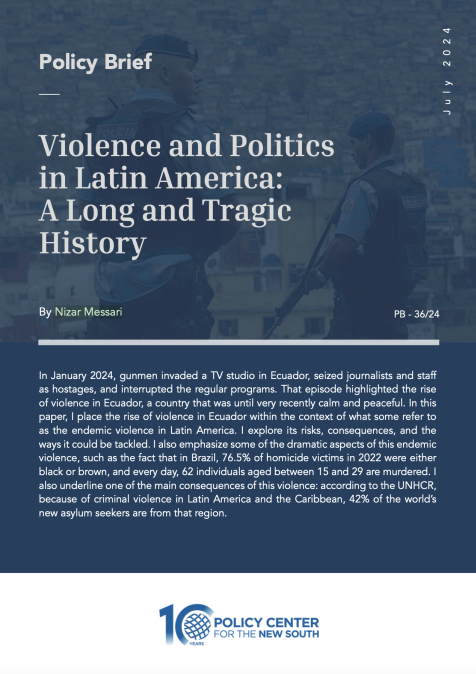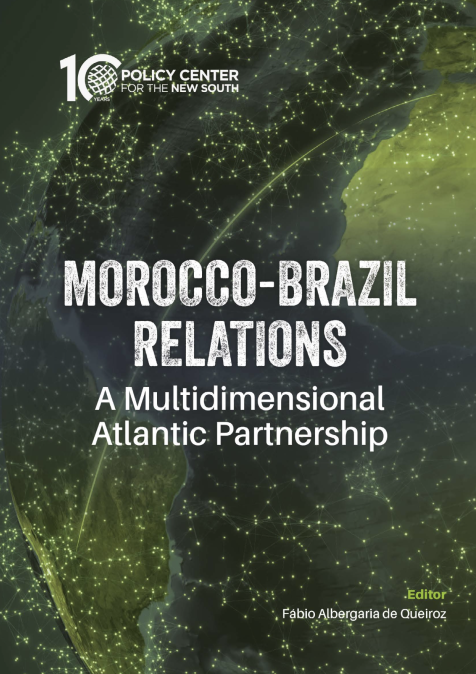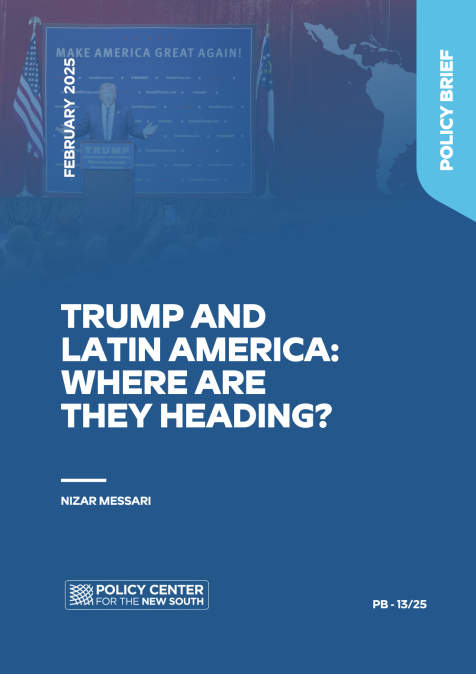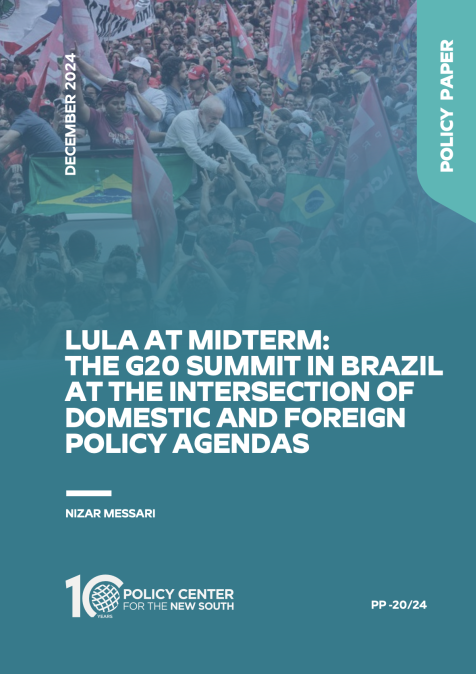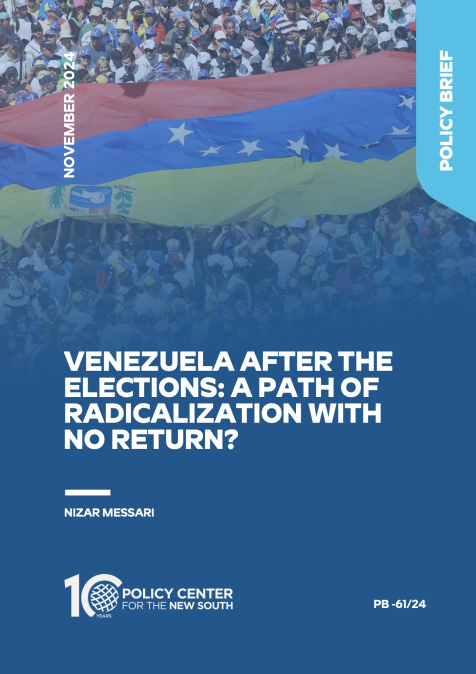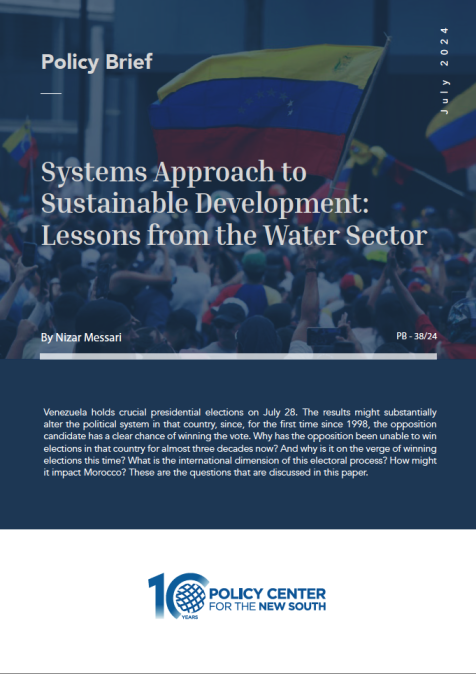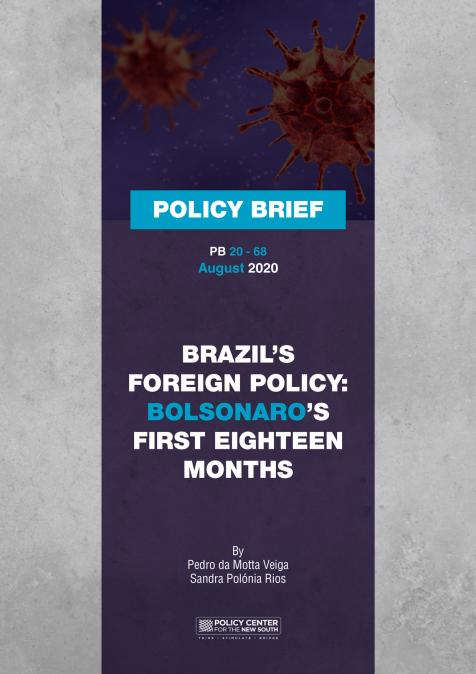Publications /
Policy Brief
In January 2024, gunmen invaded a TV studio in Ecuador, seized journalists and staff as hostages, and interrupted the regular programs. That episode highlighted the rise of violence in Ecuador, a country that was until very recently calm and peaceful. In this paper, I place the rise of violence in Ecuador within the context of what some refer to as the endemic violence in Latin America. I explore its risks, consequences, and the ways it could be tackled. I also emphasize some of the dramatic aspects of this endemic violence, such as the fact that in Brazil, 76.5% of homicide victims in 2022 were either black or brown, and every day, 62 individuals aged between 15 and 29 are murdered. I also underline one of the main consequences of this violence: according to the UNHCR, because of criminal violence in Latin America and the Caribbean, 42% of the world’s new asylum seekers are from that region.
Introduction
In News of a Kidnapping, Colombian novelist and Nobel Prize winner Gabriel García Márquez narrated the stories of 10 kidnappings in the early 1990s of prominent individuals in Colombian society by drug lords from the then sadly famous Medellin Cartel. In that book, fully based on a true story, García Márquez included observations that only a shrewd and experienced observer of Colombian society could have made. Indeed, as Colombia had agreed with the U.S. government to extradite drug lords who were serving jail sentences in Colombia, these individuals, including the most famous among them, Pablo Escobar, rejected that accord and decided to resist it. To do so, they kidnapped often famous and influential figures from Colombian high society and its political elite, in order to pressure the government and dissuade it from following through with that agreement.
In his magnificent literary style, García Márquez described the communiqués produced by Escobar and his followers, in which they demanded an end to police violence in the poor neighborhoods, as along with specific improvements to the social and economic welfare of Colombia’s poor, before they mentioned, as a final request, the end of illegal extraditions of Colombian citizens to serve their sentences in foreign jails. He also described how, with the weak presence of the state social welfare operations in poor neighborhoods, Escobar and his allies provided social services, economic support, and protection to the poor, in exchange for their loyalty, making Escobar almost into a philanthropist who was feared, but who was also—in a way—a benefactor. With that narrative, García Márquez summarized in a few concise lines what social scientists take thousands of words to narrate. I refer here to the intermingling between poverty, police violence, and the fine line gangs and criminal groups tread to make their illegal businesses prosper while using violence against the poor, against the police, and against each other, while also providing those same poor people with some protection and some support. The criminal gangs fill the spaces left empty by the state, and gain some level of loyalty among the poor.
This is neither new nor recent, and it concerns most of Latin America. In most countries of the region, violence is on the rise. The average rise in the homicide rate over the last few years in the region has been 3.7% a year, “more than three times the population growth rate of 1.1%” (Mohor, 2023). The Inter-American Development Bank (IADB) considers that crime and violence constitute an obstacle to sustainable development and to economic growth in Latin America and the Caribbean. And the International Monetary Fund (IMF) “… suggests that bringing the crime level in Latin America down to the world average would increase the region’s annual economic growth by 0.5 percentage points – around a third of Latin America’s growth between 2017 and 2019” (The Conversation, May 7, 2024).
According to IADB, the average homicide rate per 100,000 people in the region is more than three times higher than the world average (18 in the continent, against a world average of 5.6). Those averages can be misleading as shown by data from Mexico, where the rate was 28.18 in 2021, Colombia (with 25.7), Brazil (with 22.38 in 2020), and Venezuela (with 19.31). By way of comparison, the homicide rate per 100,000 inhabitants in the U.S. in 2021 was 6.81; in Canada in the same year it was 2.07; in Europe, in 2017, it was 1.7; while in Morocco, in 2021, it was 1.4. Finally, as alarming as the homicide rates, is the fact that 50% of total homicides are linked to organized crime, as compared to 24% as a world average (IADB). According to a study published by the Bloomsbury Intelligence & Security Institute, “[g]ang-perpetuated homicides numbered 21,865 in 2021 alone, although the real number of casualties is likely to be much higher”, which leads it to refer to gang violence in the region as an endemic problem.
In this paper, I explore the different types of violence in Latin America, their impact on their respective societies, the role of drug trafficking in worsening an already bad situation, and the possible remedies to it, which include police reform. I explore the potential parallels with Morocco, and the lessons that can be learned, both positive and negative, from the Latin American experience.
Political Violence
Political violence has long existed in Latin American politics. Guerrilla movements attempted—and mostly failed—to unseat governments through armed struggle throughout a good part of the second half of the twentieth century. The success of two of them (first, the Cuban revolution in 1959, and 20 years later, the Sandinista revolution in Nicaragua) created an incentive for many other groups throughout the region to pursue the same outcome. The tendency to resort to weapons to unseat governments became more pronounced as more and more countries in the region fell under military rule as Latin America became—voluntarily or not—embroiled in the Cold War. Indeed, the more the U.S. emphasized the communist threat, the more it supported its allies in the region, pre-eminently the military, in taking more radical political action and disrupting the political game by mounting military coups. If the objective of the U.S. was to stop what it saw as the spread of communism in its backyard, that radicalization of the regimes reduced the space for politics and created incentives, throughout the region, for groups to resort to armed struggle.
In that context, the eventual success in 1959 of the Cuban revolution led by Fidel Castro and Ernesto ‘Che’ Guevara against the deeply fraud regime of Fulgencio Batista represented an incentive for many other groups engaged in armed struggle to believe it was possible to reach power through bullets, once ballots were no longer an option. In Colombia, FARC (Fuerzas Armadas Revolucionarias de Colombia or Revolutionary Armed Forces of Colombia) and ELN (Ejército de Liberación Nacional, or National Liberation Army) found inspiration for their armed struggles in the success of the Cuban revolution, while Bolivia’s ELN (Ejército de Liberación Nacional de Bolivia or National Liberation Army of Bolivia) found not only inspiration in the Cuban model, but also effective support through the participation of the Che himself and some Cuban fighters in the Bolivian armed struggle.
Although the situation in Peru was slightly different for many reasons that would be too long to detail here, it also saw a surge by an armed struggle movement—which was extremely violent and bloody—in the late 1960s, the Sendero Luminoso (or Shining Path). Later, Argentina’s Montoneros and ERP (from Ejercito Revolucionario Popular or People’s Revolutionary Army), Urugay’s Tupamaros, Chile’s MIR (Movimiento de Izquierda Revolucionaria, or Revolutionary Left Movement), and Brazil’s MR-8 (Movimento Revolucionário 8 de Outubro, Revolutionary Movement of October 8—October 8 being the day Che was captured), to name but a few, all engaged in the risky business of armed struggle ... and failed.
It would also take too long to explore here the causes of those multiple failures, but as Timothy Wickham-Crowley (1992) showed, the specific causes that led to the success of Fidel Castro and his troops in Cuba—some of which were internal causes while others were external—were not the same in the other countries of the region. This led to the failure of all the other attempts until the Sandinista revolution of 1979 in Nicaragua managed to bring down the Somoza regime[i]. What should be noted here, however, is that until the end of the Cold War, guerilla movements were common in Latin America, and were behind political violence, but they were ideological and political in nature. Although some of them, such as Peru’s Sendero Luminoso, were extremely violent—blood thirsty, as some refer to them—their violence was restrained, targeted, and politically motivated: to become rulers in place of the rulers.
After the end of the Cold War, several of these guerilla movements disappeared, either because they became active participants in the political game (as in Brazil) or because they were defeated and even decimated by the powers in place (as in Peru). Some of those guerilla movements that remained began to be accused of resorting to illegal trade—mainly drug trafficking—to support their actions financially. According to Benavides (2022), in Colombia, “[w]ith the fall of the Soviet Union in the 1980s, the guerrilla groups turned to drug trafficking, kidnapping and money laundering to fund their operations. The war became the ideal backdrop for criminal organizations to carry out their activities, while organized crime and the drug trade made it possible for guerrilla groups to survive”. However, Ettore Asoni raises a relevant consideration about the timing of this heavy accusation against guerilla groups. From this perspective, the launching in 1998 by then recently elected President Andrés Pastrana of a peace initiative towards FARC and ELN meant that “… the Colombian government needed to acknowledge the political nature of the guerrillas if it wanted to reach a successful peace process ... the FARC were open to discuss disarmament, but only if political reforms would also be put on the table. Thus, the government could not simply deny their political nature, or the process would have failed. But following the failure of the 1998’s peace process, the government embraced the rhetoric that sees the guerrillas as narcoterrorists or narcoguerrillas …” (2019, emphasis in the original). The ultimate consequence of this rhetoric about guerilla movements resorting to drug trafficking to finance their actions was that it blurred the line between counterinsurgency and counternarcotics, and allowed for the criminalization of guerilla movements.
So how about non-politically based violence?
Criminal Violence
The numbers cited above about the very high homicide rates in Latin America are not about political violence, but about criminal violence. They reflect victims of clashes between criminal gangs that fight for hegemony within and outside prisons, as well as militias and police violence. In this part of the paper, I deal with this kind of violence, and I emphasize the important role played by gangs engaged in illegal trade. I also shed light on the situation in Latin America’s significantly overcrowded jails, and the humanitarian and security consequences of that situation. In the next part of the paper, I analyze the police reforms that have taken place across the continent, and their impact on reducing insecurity. While I keep my analysis at the regional level, I bring in specific cases from different countries to illustrate my argument.
Gangs have spread havoc in many Latin American countries and have caused insecurity throughout the region. Gangs often try to avoid calling attention to their activities and attempt, as much as possible, to keep the police and other authorities away. However, on several occasions, gangs have made a point of flexing their muscles and showing their might in the open. They have thus challenged authorities in many countries. According to Daniela Mohor (2023), “in Haiti, gangs control 80% of Port-Au-Prince … in Ecuador, homicides rose more than 86% just between 2021 and 2022 … In Colombia … extortion cases reportedly jumped 40% year-on-year in the first quarter of 2023. In Mexico, the number of criminal groups doubled between 2010 and 2020. To give just one example of what that means for civilians, disappearances of women in northern Zacatecas state soared by 50% last year (2022).”
Since I explored the case of crime and gang violence in Mexico in the context of the presidential election in that country and the challenges ahead for the new president (Messari, 2024), I focus here on the cases of Brazil and Ecuador for their significance in the region. In the case of the former, although it is not an illicit drug producer, its criminal gangs play a major role in international drug trafficking, and have significantly extended their international activities. The significance of Ecuador arises from the fact that it was until very recently one of the most peaceful countries in the region, with very low crime rates and little impact of gang activity in its political system. But it quickly became an extremely violent country, in which criminal gangs threaten political institutions. Moreover, I discuss the situation in El Salvador in the section about police reform, while I cover the situation in Colombia throughout this paper.
Brazil
In May 2006, the city of São Paulo, the largest in Brazil and in South America, the heart of the Brazilian economy and its main financial center, came under lockdown. That lockdown was not decreed by legal authorities, it was not due to a pandemic, although it was effective in the sense that streets were deserted, schools and offices were empty, and people stayed at home. That lockdown was imposed, from prisons, by a criminal faction, infamously known as PCC (from the initials in Portuguese of Primeiro Comando da Capital, or First Command of the Capital), and related to the transfer of prisoners from that faction to a more secure penitentiary facility. The city came to a total paralysis while a rebellion involved 84 penitentiary institutions and resulted in 299 attacks on official facilities, 82 buses burned, 17 bank branches attacked, and 42 police officers and security agents killed, in addition to 38 injured. In total, between May 12 and May 21, 2006, São Paulo registered 564 deaths, out of which approximately 400 were directly related to PCC attacks (O Globo, June 11, 2024).
The São Paulo lockdown brought to the attention of the population at large the PCC and its operation and stressed the influence and impact of criminal groups on society. Indeed, whereas criminal gangs try as much as possible to remain underground and to avoid attracting the attention—and even more so, the presence—of police into their vicinities, in May 2006, PCC acted otherwise, and exhibited its power to the authorities and to the population at large. It became evident, according to Benavides (2022) that “[t]he main challenge to Brazil’s stability is posed by criminal organizations, which operate in the country’s cities and around the Triple Frontier [the border between Brazil, Argentina and Paraguay]. They also have a dominant presence in Brazilian prisons, something that poses a risk to the country’s democratic governance”. Moreover, the PCC is present not only in Brazil but also in Latin America, in addition to the United States and parts of Europe and the Middle East, in a total of at least 24 countries. Estimates are that it has approximately 42,000 members, with around 13,000 in São Paulo, and some 27,400 throughout the rest of Brazil, the remaining 1,600 members being in the other 23 countries in which it is present. Its estimated annual revenue is at least $1 billion, and is mostly based on international drug trafficking. Indeed, 80% of PCC’s profit comes from international trafficking, and only 20% is based in Brazil (O Globo, June 9, 2024).
The creation of the PCC underlined that some of the observations of Gabriel García Márquez about Pablo Escobar, the Medellin Cartel, and Colombia, applied to Brazil too. The PCC was created on August 31, 1993, to combat state and police abuses. A year earlier, the sadly famous Carandiru prison massacre took place during an inmate rebellion. In that massacre, 111 prisoners (all black or almost black, as goes the song of Caetano Veloso) were massacred by penitentiary guards (who were also all black or mostly black, according to that same sad song of Caetano). That episode even appears in the gang's original statute as the main source of motivation to create it.
In 2017, Brazil reached a peak in violent deaths, the highest number in its history. The cause: a war fought between the PCC and the Rio de Janeiro-based gang called Comando Vermelho (CV) (Red Command). CV was first to start operating in Paraguay, long before PCC arrived there. Paraguay was an interesting target for both gangs, not only because it produces marijuana, but it is also a transit country for cocaine produced in Bolivia, Colombia, and Peru. After initially coexisting peacefully, the PCC began to suspect and later accuse the CV of going behind its back to extend its influence to other Brazilian states through direct links with local chiefs. The PCC declared war on CV, and the attacks spread to the penitentiaries, as the PCC realized that it was there, almost more than in the streets—where drugs are sold—that it needed to establish its dominance over its rival faction.
When the conflict escalated and threatened to backfire, ways to establish a truce between both factions started to be explored and eventually found. Lincoln Gakiya, a state prosecutor from the Special Action Group for the Repression of Organized Crime of the São Paulo Public Ministry declared to O Globo that “[t]he truce resulted in deaths in penitentiaries practically ceasing, and this had a positive impact on the homicide rate in the country. [Gakiya] do[es] not credit this reduction to the public policy of any state in Brazil. What happened was an agreement between criminals” (O Globo, June 10, 2024).
Finally, a particular facet of violence in Brazil is that it touches and impacts far more poor Afro-Brazilians than any other category of the population.The Atlas of Violence, published by the Institute of Research in Applied Economics (Ipea), showed that in Brazil, 86% of individuals accused of drug trafficking are men, 72% are less than 30 years old, and 68% are black or brown. As dramatic as the previous numbers was the fact that out of the 35,531 victims of homicide in Brazil in 2022, 76.5% were either black or brown. Finally, and according to the same official study, every single day, 62 individuals aged between 15 and 29 are murdered (O Globo, July 6, 2024). Along the same lines, a study published two decades ago showed that police tended to be suspicious and arrest mostly men, black or brown, from poor neighborhoods. Among individuals taken into police custody more than ten times, 94% are men, 66% are black or brown, 35% live in Favelas (Brazilian shantytowns), and 33% live in other poor neighborhoods (O Globo, July 6, 2024).
Ecuador
On January 8, 2024, gunmen stormed a TV station in Guayaquil, Ecuador, during a live transmission. They took journalists, technicians, executives, and staff present in the premises that day as hostages. Under other circumstances and in other countries, one would have thought that the invasion of the TV station was part of a military coup attempt. But that day, no one was totally surprised to learn that it was gunmen who were behind it. Indeed, a few days earlier, clashes and disruptions started taking place around the country when an important gang leader, Adolfo Macías, known as Fito, sentenced to a 34 years jail sentence, disappeared from prison. Explosions, gunfire, rebellions in prisons and the street, and looting of property started taking place around the country, creating fear around Ecuador. A few months before that, a famous investigative journalist, Fernando Villavicencio, who was running for president in the national presidential elections of 2023, had been assassinated.
As a consequence of the unprecedented security crisis in the country, President Daniel Noboa—who had just been elected president in October 2023—declared a 60-day state of emergency, imposed a nationwide curfew, and authorized the military to patrol the streets and take control of prisons. In his statement, President Noboa called the criminal gangs terrorist organizations, and stated that an internal armed conflict was underway as he ordered the military to “neutralize” those gangs.
But Ecuador’s descent into insecurity is fairly recent. Before the COVID-19 pandemic, Ecuador was a relatively safe country, with homicide rates far lower than the average Latin American rates. However, according to InSight Crime, an organization that has specialized in Latin American and Caribbean security, homicides rose in Ecuador by almost 90%, compared to the previous year, in both 2022 and 2023. From an average of approximately 5 homicides per 100,000 inhabitants a year before the COVID-19 pandemic, the Ecuadorian rate rose to 40/100,000 in 2023. According to Human Rights Watch, the violence flareup in Ecuador is due to wars between essentially two main factions, the ‘Choneros’ and the ‘Lobos’, who, with allied drug traffickers from Colombia, Mexico, and Albania, are trying to establish their hegemony over the trade routes through which drugs circulate and reach their final markets. According to France 24 journalist Samuel Salgado, the international character of the gang war became evident with the arrest of six Colombians linked to the assassination of Villavicencio, the journalist turned presidential candidate (France 24, August 12, 2023). Just like in Brazil, prisons are the site of the gang fighting: between 2019 and 2023, estimates are that at least 400 inmates were murdered in Ecuadorian jails (El Confidencial, January 10, 2024). According to many experts cited by the New York Times, as many as a quarter of the country’s prisons are now controlled by gangs (NYTimes, January 10, 2024).
The cases of Brazil and Ecuador, and that of Mexico, which was explored previously, show a similar dynamic: violent clashes take place between criminal gangs that are fighting to control illegal trade, mainly drugs. Since many ring leaders are jailed, assassinations take place as much in jails as they take place in streets. Significantly, none of the three countries (Brazil, Ecuador, and Mexico) is a producer of illegal drugs, but all three constitute important stops in the illegal trafficking routes.
The consequences of this insecurity are many. The first obvious one is the loss of human lives, and the impact that has on surviving families, as well as on society at large. Lower life expectancy in favelas is rather the norm than the exception, which in itself is tragic. Moreover, as previously noted, another consequence, according to the IMF and the IADB, is slowing economic growth and development. A third consequence has also a dramatic human dimension. I refer here to a significant rise in refugees from the region, who flee their countries because of extremely high levels of criminal violence. According to Mohor (2023), “[i]n Colombia, the splintering of armed groups and their rivalry over drug trafficking routes saw new conflict displacements rise in 2022 to a decade high of 339,000 … while in Haiti, gang violence led to 106,000 displacements in 2022 … A March [2023] monitoring report by the UN’s refugee agency (UNHCR) from the Darién Gap – a key escape route for many – revealed that three in ten migrants or asylum seekers interviewed had left their country of origin because of threats or attacks directed against them or their families … [and] [a]ccording to UNHCR, by mid-2022, 42% of the world’s new asylum applications came from Latin America and the Caribbean” (emphasis added). At the risk of underlining the obvious, I note here that the last number should be surprising since Latin America and the Caribbean are not seeing major wars, civil wars, or significant UN-backed peace operations, Haiti excepted. Indeed, it is sad to expect that refugees would come from war zones in the wider Middle East and Africa, so when the UNHCR notes that 42% of the world’s new asylum seekers come from Latin America and the Caribbean, it underlies the dramatic human cost and the high level of insecurity that people and communities in the region experience.
Overcrowded jails
In a journalistic investigation, which was published in July 2024 simultaneously in many Latin American daily newspapers, the findings were truly alarming: in prisons in Argentina, Brazil, Chile, Colombia, Costa Rica, El Salvador, Mexico, Peru, Dominican Republic, Uruguay, and Venezuela, jails are significantly overcrowded, and living conditions are extremely difficult, creating fertile ground for the expansion of the activities of criminal gangs, and feeding their businesses outside of prison (O Globo, July 30, 2024). Moreover, throughout the region, thousands of inmates spend years in jail without ever being sentenced.
In most of the 11 countries/cases mentioned above, from 2016 to 2022, the numbers of inmates increased. The exceptions were Colombia, Costa Rica, and Venezuela. One of the consequences of overcrowded jails is violence. In Mexico, in 2019, 677 cases of violence were reported, and that number increased to 2499 in 2022. In Colombia, in March 2021 (during the COVID-19 pandemic), a rebellion in a jail resulted in 24 deaths and 107 injured, and a similar rebellion with similar consequences took place in Argentina shortly after that. Similarly to what I have already noted, the investigative journalists argued that violence in Latin American prisons is closely linked to the existence of gangs and their fight for hegemony, both inside and outside jails. As for the troubling issue of inmates waiting for sentences, the investigative journalists found that in Venezuela, only 47% of inmates had received a jail sentence, whereas in Mexico, Peru, and Chile, that number rises to approximately 60%. Although the situations in Brazil and Colombia are better, 25% of inmates were still waiting for a sentence, whereas in Uruguay, that number was only 15%, and in the Dominican Republic, less than 10%.
So what has been done or attempted to deal with these high levels of insecurity in the region? This is what I discuss in the next part of this paper, and I focus in particular on police reform attempts in Latin America.
Police Reform or How to Reestablish Order and Trust
Without adopting a Marxist perspective, many Latin American politicians, broadly speaking from the progressive camp, make an argument more or less as follows: the poor see the state as an instrument in the hands of the elites. The state is a status-quo agent that gives the elites protection to go on with their lives and allows them to continue to rule. Strengthening the state has translated, in the eyes of the poor and the marginalized, into strengthening a tool of repression and oppression. This was the case because under the military dictatorships of the 1960s, 1970s, and early 1980s, there was a militarization of the police in the region, and it was hard to separate the police from the military: the former was dominated by the latter or contributed to its rule (Frühling, 2009, p. 23).
Mary Malone and her co-authors supported this argument, arguing that:
Historically, policing in Latin America had a political dimension, as police served to support the power of incumbent governments and control citizens. Especially in the 1970s and 1980s, military dictatorships incorporated police institutions as fuerzas de choque (repressive forces) … Under authoritarian rule, the primary objective of the police was typically protecting the regime and its major stakeholders, and the police often relied heavily on the indiscriminate use of force to achieve this goal (2023).
This is supported with data from the Latinbarometro[ii], which shows that in 2003, while 62% of Latin Americans trusted the church, only 29% trusted the police, and 20% trusted the justice system. Along the same lines, in 2004, 65% of Mexicans, 58% of Paraguayans, and 57% of Argentines thought it was possible to bribe a member of the police (Frühling, 2009, p. 22). But left-leaning politicians are not anti-police and, some, like Andrés Manuel López Obrador (AMLO) in Mexico, and Lula in Brazil, admit that the poor as much as the elites, need the police and need police protection, so they argue for the necessary reform of the police, and for the need to bring the police closer to the people, all the people. They argue that in order to be more effective, the police must be reformed substantially to gain the trust of all, and not only of the elites.
How could that be achieved? According to Malone and her co-authors, although police in Latin America have been known for violence and corruption, over the last 30 years, police reforms in some countries has improved on that reputation: “The Chilean and Nicaraguan forces in particular had been commended for building police–community ties, respecting citizen rights, and engaging with local communities. The Colombian police earned accolades for increasing levels of professionalism and efficiency and initiating some community-oriented initiatives in major cities” (Malone et al, 2023, p. 1). They added that “… there has been widespread acknowledgment that the police should establish (and deepen) a strong, constant, active, and positive relationship with citizens. Most police institutions in the region have created community policing programs, and while the results are often mixed, such efforts are a step forward” (Malone et al, 2023, p. 4).
But the path to establish trust between people and the police, and more particularly, between the poor and the police, involves a long process, and has to overcome several hurdles. Reforms need to be comprehensive, and must deal simultaneously with corruption in the police ranks, with violence, and with effectiveness, including through more community-based and less-repressive policies. The path dependency that led to mistrust should be replaced by a more virtuous path dependency that would lead to the establishment of trust. Reforms should also tackle the lack of training of the police, including in terms of awareness of human rights laws, as well as their low wages.
But on the other side of the political spectrum, there are those politicians who argue for what is known in the region as the politics of the strong hand (Mano Dura). According to them, it is necessary to fight violence with violence, and to be implacable with criminals in order to bring safety to all. They reject the image of the instrumentalization of the state by the elites, and counter it with one in which good citizens have nothing to fear, while the bad guys should tremble because the state will inevitably come after them. Governments that adopt this approach, including those of Nayib Bukele in El Salvador, Daniel Noboa in Ecuador, and Alvaro Uribe before them in Colombia, are:
… enacting states of emergency, putting through policies they would normally not be authorized to do, for the safety and protection of their citizens … this approach involves suspending the fundamental rights of the citizenry by giving the military and law enforcement agencies the power to arrest, incarcerate and deport anyone found to be involved with criminal gangs. It also denies access to legal measures to establish the arrested person’s right to a fair and open trial (The Conversation, May 7, 2024).
In El Salvador, this kind of policy was established by President Bukele in March 2022. Two years later, by the end of February 2024, more than 76,000 people had been detained. That is almost 2% of the total population of the country. While critics “have decried the crackdown as a gross human rights violation. Troops have rounded people up for having tattoos and being in poor neighborhoods, leading to the detention of thousands of innocent people in overcrowded Salvadorian jails … many people in El Salvador have accepted the crackdown with open arms” (The Conversation, May 7, 2024). As a matter of fact, President Bukele was re-elected in February for a new presidential mandate in a landslide victory. The message was: rule of law is good, but under the circumstances El Salvador was going through before the implementation of Mano Dura, what Salvadorans wanted most was peace, safety, and security. And as noted above, President Noboa in Ecuador is following the same path, although it is not yet clear whether it will be to the same extent.
In sum, Latin America continues to be a vibrant and lively laboratory in which different policies and approaches are attempted, including in relation to police reform. In the next part, I discuss the relevance of what has been happening in Latin America for Morocco.
Lessons for Morocco
A few months ago, the Moroccan press started to discuss accusations against relatively prominent Moroccan politicians, and their links to what has been referred to since then as ‘Escobar of the Sahara’. That development shed light on several issues: the fact that drug traffickers were seeking to influence politicians in Morocco, the fact that they were reaching relatively prominent politicians in the country, and last but not least, the significant reference to Colombia and to Pablo Escobar.
In Latin America in general, and in Colombia in particular, drug lords have long sought to establish links with politicians. President Ernesto Samper of Colombia (1994-1998), was accused of accepting funds for his presidential electoral campaign from the Cali cartel, one of the most important and influential drug cartels in the region. He was declared persona non grata by the United States, and fought, throughout his presidency, the suspicion of being linked to—and protecting the interests of—drug lords. President Samper was only the most prominent politician accused of connivence with drug cartels. Several others have been suspected and/or accused of having hidden relations with criminal gangs, and of ultimately protecting them.
As constant seizures of different types of illegal drugs in Moroccan ports and airports clearly indicate, Morocco is becoming a significant platform for drug trafficking, because of its proximity to Europe and the pre-existence of small and incipient criminal gangs in the country. This situation brings many substantial risks to Morocco, as cases of countries little troubled by drugs which quickly became extremely violent—such as Ecuador—show. The existence of other illicit trafficking between Morocco and Europe (human trafficking) makes the activities of these gangs a very significant challenge. The Latin American experience is a relevant model to explore for eventual future emulation. Indeed, the fact that the press has immediately entitled the Moroccan drug lord as ‘Escobar of the Sahara’ underlines the relevance of the comparison, and the many lessons that can be learned from the Latin American case. Tackling the challenge of the influence of drug traffickers in Moroccan politics heads on and learning from the Latin American case is extremely important. In particular, adopting police reform as a necessity, but adapting it to Morocco’s circumstances, is necessary and relevant.
Conclusion
Violence in Latin America has been endemic for many decades. It has a political component, and a criminal one. After the end of the Cold War, some governments argued that several guerrilla movements, with political agendas, resorted to illicit trafficking to sustain their operations. This has led to a rising ambiguity about the difference between guerilla movements and criminal gangs. Still, violence remains a very important characteristic of Latin American societies.
In this paper, I presented some key aspects of this violence, and shed light on some of its troubling characteristics, such as the fact that its victims are mainly the poor. I also emphasized the many costs of this violence in the region. I concluded with the risk that Morocco could see the Latin American model reproduced on its territory.
Bibliography
Asoni, Ettore, (2019) “Drug Wars and the Neoliberalization of the Space in Latin America”, Diacronie – Studi di Storia Contemporanea, N. 39/3, 2019. https://journals.openedition.org/diacronie/11908,
Benavides, Farid, (2022) “The Challenges to Peace in Latin America: From Guerrilla Warfare to the Fight Against Organised Crime”, Idees, 12 May 2022, https://revistaidees.cat/en/the-challenges-to-peace-in-latin-america-from-guerrilla-warfare-to-the-fight-against-organised-crime/, Accessed on June 24, 2024.
Bloomsbury Intelligence & Security Institute, “The Invisible War: Latin America’s Gang Violence”, 1 Februrary, 2024, https://bisi.org.uk/reports/the-invisible-war-latin-americas-gang-feuds, Accessed, on June 21, 2024.
Castañeda, Jorge G., (1993) Utopia Unarmed – The Latin American Left after the Cold War, (New York: Vintage Books)
El Confidencial, Héctor Estepa, “La espiral de violencia engulle a Ecuador: el presidente declara 'conflicto armado interno' por las bandas”, January 10, 2024, https://www.elconfidencial.com/mundo/2024-01-10/la-espiral-de-violencia-engulle-a-ecuador-bandas-armadas-ecuador_3808335/, Accessed on June 25, 2024,
The Conversation, “Latin America: several countries look to combat gang violence by fighting fire with fire”, May 7, 2024, https://theconversation.com/latin-america-several-countries-look-to-combat-gang-violence-by-fighting-fire-with-fire-228941, Accessed on June 25, 2024.
France 24, Samuel Salgado, “¿Qué bandas criminales están detrás de la ola de violencia en Ecuador?”, August 12, 2023, https://www.france24.com/es/am%C3%A9rica-latina/20230812-qu%C3%A9-bandas-criminales-est%C3%A1n-detr%C3%A1s-de-la-ola-de-violencia-en-ecuador, accessed on June 25, 2024.
Frühling, Hugo, 2009, “Recent Police Reform in Latin America” In Policing Insecurity: Police Reform, Security, and Human Rights in Latin America, Niels Uildriks (Ed.), (Lanham, Md: Lexington Books)
Inter American Development Bank (IADB), “Seguridad Ciudadana en América Latina y el Caribe”, March 7, 2024, https://www.iadb.org/es/noticias/seguridad-ciudadana-en-america-latina-y-el-caribe, Accessed on June 24, 2024.
Malone, Mary Fran T., Dammert, Lucía and Pérez, Orlando J., 2023 Making Police Reform Matter in Latin America, (Lynne Rienner, Boulder)
Messari, Nizar, “Mexico After Andrés Manuel López Obrador: Challenges and Opportunities”, June 4, 2024, https://www.policycenter.ma/publications/mexico-after-andres-manuel-lopez-obrador-challenges-and-opportunities, Accessed on July 17, 2024. ohor, Daniela, The New Humanitarian, “Surging gang violence across Latin America challenges aid sector to respond”, May 17, 2023, https://www.thenewhumanitarian.org/analysis/2023/05/17/gang-violence-latin-america-challenge-aid-sector, Accessed on June 21, 2024.
NYTimes, Jin Yu Young, “What to Know About the Chaos in Ecuador”, January 10, 2024, https://www.nytimes.com/2024/01/10/world/americas/ecuador-emergency-prisons-gangs.html, Accessed on June 20, 2024.
O Globo, Aline Ribeiro, Hyndara Freitas e Rafael Garcia, “PCC já atua em 24 países, soma mais de 40 mil membros e envia drogas aos cinco continentes”, June 9, 2024, https://oglobo.globo.com/brasil/especial/pcc-ja-atua-em-24-paises-soma-mais-de-40-mil-membros-e-envia-drogas-aos-cinco-continentes.ghtml accessed on June 9 2024.
O Globo, Aline Ribeiro e Nicolas Iory, “Multinacional do tráfico: como o PCC 'tomou' o Paraguai, a guerra com o CV e a 'paz' via acordo milionário”, June 10, 2024, https://oglobo.globo.com/brasil/especial/multinacional-do-trafico-como-o-pcc-tomou-o-paraguai-a-guerra-com-o-cv-e-a-paz-via-acordo-milionario.ghtml, Accessed on June 10, 2024.
O Globo, Aline Ribeiro, Hyndara Freitas e Nicolas Iory, “Racha no PCC: áudio em que Marcola chama comparsa de 'psicopata' põe em xeque os rumos da maior facção do país” 11 de junho de 2024, https://oglobo.globo.com/brasil/especial/racha-no-pcc-audio-em-que-marcola-chama-comparsa-de-psicopata-poe-em-xeque-os-rumos-da-maior-faccao-do-pais.ghtml, Acessado em 11 de junho de 2024.
O Globo, Guadalupe Galván e Daniela Wachauf, “Superlotação, ação do crime organizado e rebeliões: o drama dos presídios na América Latina”, July 30, 2024, https://oglobo.globo.com/mundo/noticia/2023/07/30/superlotacao-acao-do-crime-organizado-e-rebelioes-o-drama-dos-presidios-na-america-latina.ghtml, Accessed on June 19, 2024.
O Globo, Flavia Oliveira, “Violência recorrente e autorizada”, July 6, 2024, https://oglobo.globo.com/rio/noticia/2024/07/06/artigo-violencia-recorrente-e-autorizada.ghtml, Accessed on July 6, 2024,
Wickham-Crowley, Timothy, (1992), Guerrillas and Revolution in Latin America: A Comparative Study of Insurgents and Regimes since 1956, (Princeton University Press)
[i] It is very important to note at this stage that there have been many left-wing groups, movements, and parties throughout Latin America that were not violent, that did not engage in armed struggle, and which kept their fight in the political ring, from Mexico to Peru, and from Chile to Brazil, to mention only a few. Several political thinkers, among whom some became politicians, from Peru’s Haya de la Torre to Mexico’s Cuauhtémoc Cárdenas Solórzano, rejected armed struggle and insisted on a leftist and reformist path (Castañeda, 1993).
[ii] The Barometer is part of a large set of polls operated around the world that monitor public opinion and keep track of its evolution on specific topics, as well as on politics, governments, and politicians.

